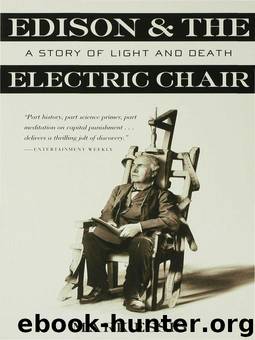Edison and the Electric Chair: A Story of Light and Death by Mark Essig

Author:Mark Essig
Language: eng
Format: mobi, epub
Tags: History
ISBN: 9780802719287
Publisher: Bloomsbury Publishing Plc
Published: 2009-05-26T10:00:00+00:00
CHAPTER 15
The Unmasking of
Harold Brown
ON AUGUST 25, just a few weeks after the hearings ended, the New York Sun published stunning revelations regarding Edison's interest in the electrocution law and his relationship with Harold Brown. "FOR SHAME, BROWN!" the newspaper's headline read. "Disgraceful Facts About the Electric Killing Scheme; Queer Work for a State's Expert; Paid by One Electric Company to Injure Another."
The Sun had gained possession of nearly four dozen letters—stolen from a locked desk in Brown's office, it was later revealed—between Brown and the officers of two electrical manufacturers, Edison Electric and Thomson-Houston. The newspaper first ran a brief excerpt from the Kemmler hearings in which Referee Becker had asked Brown if he was "connected in any way with any of the electric lighting companies," and in particular if he had "any connection with the Edison Company . . . or Thomas Edison." Brown's reply had been "No, sir." The Sun then reproduced a letter Brown subsequently received from his father, who wrote, "I was a little surprised at your statement that you were not connected with any electric company. I thought you were." The rest of the letters—reprinted in full in the Sun—proved that Brown's father was right, although the arrangements were more complicated than the critics of Brown had imagined.1
The Sun printed a letter Brown received in February 1889 from Frank Hastings, the secretary-treasurer of the Edison Electric Light Company, asking Brown to send a copy of his pamphlet The Comparative Danger of the Alternating and Direct Currents to all of the "legislators and officers of the State of Missouri," who were considering a bill that would limit the voltage of alternating current. The cost of printing and mailing the pamphlet to every legislator in Missouri must have been enormous, and Brown was not a wealthy man. The tone of Hastings's letter made it clear that he was giving Brown instructions in the matter; Edison Electric probably paid for the printing and mailing costs as well.2
A month later, in March 1889, Brown sent a letter to Thomas Edison, explaining that he was trying to persuade the city of Scranton, Pennsylvania, to place restrictions on alternating current. Brown said that if Edison would publicly endorse his efforts, he would be able "to add Scranton to the list of cities which have shut out the high-tension alternating current." Edison told Brown that he would be happy to oblige.
My Dear Sir:
I have your letter of 17th instant., and take much pleasure in enclosing herewith a testimonial signed by myself, which I hope will answer your purpose.
Yours very truly,
Thomas A. Edison.3*
A few days later, after winning the state contract to supply execution equipment, Brown wrote to Edison with another request. The generators would cost thousands of dollars, Brown explained, but the state would not repay him until after the first prisoner was electrocuted. He could undertake the plan only "if $5000 is made available" for him to use, and he needed Edison's help in acquiring that money.
In view of the
Download
Edison and the Electric Chair: A Story of Light and Death by Mark Essig.epub
This site does not store any files on its server. We only index and link to content provided by other sites. Please contact the content providers to delete copyright contents if any and email us, we'll remove relevant links or contents immediately.
| Electricity | Magnetism |
The Complete Stick Figure Physics Tutorials by Allen Sarah(7334)
Secrets of Antigravity Propulsion: Tesla, UFOs, and Classified Aerospace Technology by Ph.D. Paul A. Laviolette(5330)
Thing Explainer by Randall Munroe(3905)
The River of Consciousness by Oliver Sacks(3571)
The Order of Time by Carlo Rovelli(3162)
How To by Randall Munroe(3074)
A Brief History of Time by Stephen Hawking(2990)
I Live in the Future & Here's How It Works by Nick Bilton(2958)
What If?: Serious Scientific Answers to Absurd Hypothetical Questions by Randall Munroe(2667)
The Great Unknown by Marcus du Sautoy(2661)
Midnight in Chernobyl by Adam Higginbotham(2515)
Blockchain: Ultimate Step By Step Guide To Understanding Blockchain Technology, Bitcoin Creation, and the future of Money (Novice to Expert) by Keizer Söze(2465)
Networks: An Introduction by Newman Mark(2382)
The Meaning of it All by Richard Feynman(2318)
Easy Electronics by Charles Platt(2307)
The Tao of Physics by Fritjof Capra(2247)
Midnight in Chernobyl: The Untold Story of the World's Greatest Nuclear Disaster by Adam Higginbotham(2195)
When by Daniel H Pink(2098)
Introducing Relativity by Bruce Bassett(2097)
